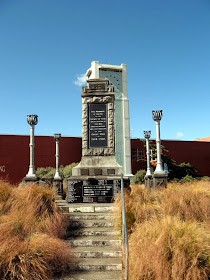6224 Private William Henry George Barry, 14th Infantry Battalion, 20th Reinforcements.
William Barry was born in Coburg (then known as
Pentridge) in 1869, the son of William and Isabella (Johnson). He did not marry
and lived with his widowed mother Isabella (nee Johnson) at 3 Barry Street (or
Barry's Lane), Coburg, a street off O'Hea Street named after his family.
William Barry was 44 years old when he enlisted. By
then he'd served in the Australian Navy for three years and been in the
1st and 4th Battalions of the Victorian Militia for four years. He'd done home
service, too, with the AIF, for four months. A big man for the time (5 feet 9
inches tall and weighing 13 stone) and used to hard physical work (he was an
ironworker on the railways), he'd been rejected as unfit before with a hammer
toe and bad teeth. Even so, he wanted to fight and he was finally accepted in
August 1916. He embarked from Melbourne on 7 September 1916 on board the Port Sydney.
Port
Sydney on the day of its departure, 7 September 1916. Photographer Josiah Barnes.
Image courtesy AWM. Image PB0910.
20th Reinforcements of the 14th Battalion on the wharf at Port Melbourne, ready to embark. 7 September 1916. William Barry is probably in this photo.
Image courtesy AWM. Image PB0913.
Port Sydney, 20th
Reinforcements, 14th Battalion. Note that the patterned sunshade that is on the left in the photo above is now being used as shelter by the two soldiers on the left. Was it a gift from a sweetheart, perhaps?
Image courtesy AWM. Image PB0917.
There are many more photos of the Port Sydney taken that day. They are all available online at the Australian War Memorial website and were all taken by Josiah Barnes, a photographer from Kew whose two sons served in the 1st AIF. He was known as the 'embarkation photographer'.
----
William Barry arrived in France on 3 March 1918. He
was wounded in the thigh and hand on 31 May 1918. On 13 June 1918, aged 47, he
was sent back to England with haemorrhoids. At the end of July he was returned
to Australia suffering from premature senility, which the medical report
claimed was pre-existing. It also noted that he had 'markedly defective vision'
in his right eye.
It's a wonder he was ever accepted in the
first place, but William Barry's four months in France gave him a taste of the
experience of war and on his return he was granted a pension. He lived with his
mother at 3 Barry Street, Coburg until the 1920s when he moved briefly to Gisborne. By then he was working as a gardener, an occupation he continued to
pursue on his return to the city, to Abbotsford, in 1931. He lived alone, his
mother having died in 1929. I have found no record of his death.
Interestingly, during the war years, his
sister Elizabeth, who was married to Chief Warder Hugh Foy, lived inside the
walls of Pentridge Prison. His father William, who died in 1909, had been a
warder at Pentridge in the 1870s and 1880s.
Sources: Attestation papers, National Archives of Australia; Victorian
Birth Index, 1869/10711; 1903, 1909, 1914,1919, 1924, 1931 and 1936 electoral
rolls.

























